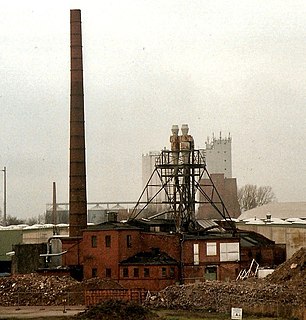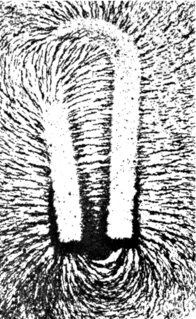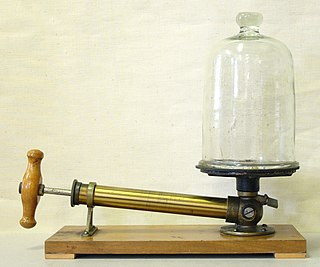
Filtration is any of various mechanical, physical or biological operations that separate solids from fluids by adding a medium through which only the fluid can pass. The fluid that passes through is called the filtrate. In physical filters oversize solids in the fluid are retained and in biological filters particulates are trapped and ingested and metabolites are retained and removed. However, the separation is not complete; solids will be contaminated with some fluid and filtrate will contain fine particles. Filtration occurs both in nature and in engineered systems; there are biological, geological, and industrial forms. For example, in animals, renal filtration removes waste from the blood, and in water treatment and sewage treatment, undesirable constituents are removed by absorption into a biological film grown on or in the filter medium, as in slow sand filtration.

Magnetism is a class of physical phenomena that are mediated by magnetic fields. Electric currents and the magnetic moments of elementary particles give rise to a magnetic field, which acts on other currents and magnetic moments. The most familiar effects occur in ferromagnetic materials, which are strongly attracted by magnetic fields and can be magnetized to become permanent magnets, producing magnetic fields themselves. Only a few substances are ferromagnetic; the most common ones are iron, nickel and cobalt and their alloys such as steel. The prefix ferro- refers to iron, because permanent magnetism was first observed in lodestone, a form of natural iron ore called magnetite, Fe3O4.

Paramagnetism is a form of magnetism whereby certain materials are weakly attracted by an externally applied magnetic field, and form internal, induced magnetic fields in the direction of the applied magnetic field. In contrast with this behavior, diamagnetic materials are repelled by magnetic fields and form induced magnetic fields in the direction opposite to that of the applied magnetic field. Paramagnetic materials include most chemical elements and some compounds; they have a relative magnetic permeability slightly greater than 1 and hence are attracted to magnetic fields. The magnetic moment induced by the applied field is linear in the field strength and rather weak. It typically requires a sensitive analytical balance to detect the effect and modern measurements on paramagnetic materials are often conducted with a SQUID magnetometer.
Isotope separation is the process of concentrating specific isotopes of a chemical element by removing other isotopes. The use of the nuclides produced is various. The largest variety is used in research. By tonnage, separating natural uranium into enriched uranium and depleted uranium is the largest application. In the following text, mainly the uranium enrichment is considered. This process is a crucial one in the manufacture of uranium fuel for nuclear power stations, and is also required for the creation of uranium based nuclear weapons. Plutonium-based weapons use plutonium produced in a nuclear reactor, which must be operated in such a way as to produce plutonium already of suitable isotopic mix or grade.
While different chemical elements can be purified through chemical processes, isotopes of the same element have nearly identical chemical properties, which makes this type of separation impractical, except for separation of deuterium.
Eddy currents are loops of electrical current induced within conductors by a changing magnetic field in the conductor according to Faraday's law of induction. Eddy currents flow in closed loops within conductors, in planes perpendicular to the magnetic field. They can be induced within nearby stationary conductors by a time-varying magnetic field created by an AC electromagnet or transformer, for example, or by relative motion between a magnet and a nearby conductor. The magnitude of the current in a given loop is proportional to the strength of the magnetic field, the area of the loop, and the rate of change of flux, and inversely proportional to the resistivity of the material. When graphed, these circular currents within a piece of metal look vaguely like eddies or whirlpools in a liquid.

A ferrofluid is a liquid that becomes strongly magnetized in the presence of a magnetic field.
A grinding process for ferrofluid was invented in 1963 by NASA's Steve Papell as a liquid rocket fuel that could be drawn toward a pump inlet in a weightless environment by applying a magnetic field. The name ferrofluid was introduced, the process improved, more highly magnetic liquids synthesized, additional carrier liquids discovered, and the physical chemistry elucidated by R. E. Rosensweig and colleagues; in addition Rosensweig evolved a new branch of fluid mechanics termed ferrohydrodynamics.

A hydrocyclone is a device to classify, separate or sort particles in a liquid suspension based on the ratio of their centripetal force to fluid resistance. This ratio is high for dense and coarse particles, and low for light and fine particles. Hydrocyclones also find application in the separation of liquids of different densities.

A cyclonic separation is a method of removing particulates from an air, gas or liquid stream, without the use of filters, through vortex separation. When removing particulate matter from liquid, a hydrocyclone is used; while from gas, a gas cyclone is used. Rotational effects and gravity are used to separate mixtures of solids and fluids. The method can also be used to separate fine droplets of liquid from a gaseous stream.

In the field of extractive metallurgy, mineral processing, also known as ore dressing, is the process of separating commercially valuable minerals from their ores.
Immunomagnetic separation (IMS) is a laboratory tool that can efficiently isolate cells out of body fluid or cultured cells. It can also be used as a method of quantifying the pathogenicity of food, blood or feces. DNA analysis have supported the combined use of both this technique and Polymerase Chain Reaction (PCR). Another laboratory separation tool is the affinity magnetic separation (AMS), which is more suitable for the isolation of prokaryotic cells.

The Proton Synchrotron (PS) is a particle accelerator at CERN. It is CERN's first synchrotron, beginning its operation in 1959. For a brief period the PS was the world's highest energy particle accelerator. It has since served as a pre-accelerator for the Intersecting Storage Rings (ISR) and the Super Proton Synchrotron (SPS), and is currently part of the Large Hadron Collider (LHC) accelerator complex. In addition to protons, PS has accelerated alpha particles, oxygen and sulphur nuclei, electrons, positrons and antiprotons.

A coal preparation plant is a facility that washes coal of soil and rock, crushes it into graded sized chunks (sorting), stockpiles grades preparing it for transport to market, and more often than not, also loads coal into rail cars, barges, or ships.
Migma, sometimes migmatron or migmacell, was a proposed colliding beam fusion reactor designed by Bogdan Maglich in 1969. Migma uses self-intersecting beams of ions from small particle accelerators to force the ions to fuse. Similar systems using larger collections of particles were referred to as "macrons". Migma was an area of some research in the 1970s and early 1980s, but lack of funding precluded further development.
An electrostatic separator is a device for separating particles by mass in a low energy charged beam.
Gravity separation is an industrial method of separating two components, either a suspension, or dry granular mixture where separating the components with gravity is sufficiently practical: i.e. the components of the mixture have different specific weight. All of the gravitational methods are common in the sense that they all use gravity as the dominant force. One type of gravity separator lifts the material by vacuum over an inclined vibrating screen covered deck.
This results in the material being suspended in air while the heavier impurities are left behind on the screen and are discharged from the stone outlet. Gravity separation is used in a wide variety of industries, and can be most simply differentiated by the characteristics of the mixture to be separated - principally that of 'wet' i.e. - a suspension versus 'dry' -a mixture of granular product. Often other methods are applied to make the separation faster and more efficient, such as flocculation, coagulation and suction. The most notable advantages of the gravitational methods are their cost effectiveness and in some cases excellent reduction. Gravity separation is an attractive unit operation as it generally has low capital and operating costs, uses few if any chemicals that might cause environmental concerns and the recent development of new equipment enhances the range of separations possible.

Drakelands Mine, formerly known as Hemerdon Mine or the Hemerdon Ball or Hemerdon Bal Mine, was a tungsten and tin mine. It is located 11 km northeast of Plymouth, near Plympton, in Devon, England. It lies to the north of the villages of Sparkwell and Hemerdon and adjacent to the large china clay pits near Lee Moor. The mine was out of operation since 1944, except for the brief operation of a trial mine in the 1980s. Work started to re-open it in 2014, but it ceased activities in 2018. It hosts the fourth largest tin-tungsten deposit in the world.

A particle accelerator is a machine that uses electromagnetic fields to propel charged particles to very high speeds and energies, and to contain them in well-defined beams.
The corn wet-milling is a process of breaking corn kernels into their component parts: corn oil, protein, corn starch, and fiber. It uses water and a series of steps to separate the parts to be used for various products.
















